The ASUS ROG Strix G15 (G513QY) Review: Embracing AMD's Advantage
by Brett Howse on May 31, 2021 11:00 PM ESTDisplay Analysis
ASUS offers two display options with the Strix G513QY, with a 300 Hz 1920x1080 option targeting the sRGB gamut, and a 165 Hz 2560x1440 panel with P3 gamut coverage. Both displays are IPS variants, and both offer 3 ms response times. AMD shipped us the 1920x1080 unit, which will be tested here.
AMD offers FreeSync Premium, meaning variable refresh rate is supported, preventing screen tearing and stuttering, and much like NVIDIA’s Advanced Optimus, the discrete GPU can be turned on and off without requiring a system reboot, while still allowing for variable refresh rate, so that is a major win.
 Matte finish leaves a haze-like appearance on the pixels
Matte finish leaves a haze-like appearance on the pixels
The 1920x1080 panel targets the sRGB gamut, which is the normal color gamut for a Windows PC. The higher resolution offering goes for the much wider gamut of P3-D65, meaning it can achieve deeper colors, however with the lack of a system-wide color management system in Windows 10 generally means that is more of a detriment than an advantage.
The display offers a matte finish, with no touch options, which is pretty much par for the course in the gaming notebook space. Touch controls are just not required, since most people will use a keyboard and mouse. The matte coating does leave a hazy finish on the display, which means the images are not quite as crisp as they would be on a display with a clear coating, but it can help with usability to have a matte coating in a room with light glare.
To test the display capabilities and accuracy, we use Portrait Display’s Calman software with a custom workflow. The X-Rite i1 Display Pro colorimeter is used for brightness and contrast readings, and the X-Rite i1Pro 2 spectrophotometer is used for color accuracy tests.
Brightness and Contrast
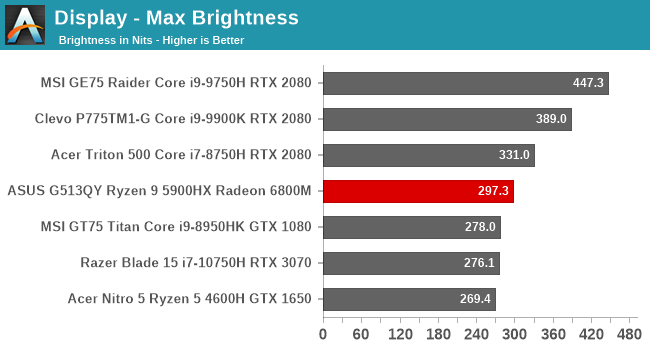
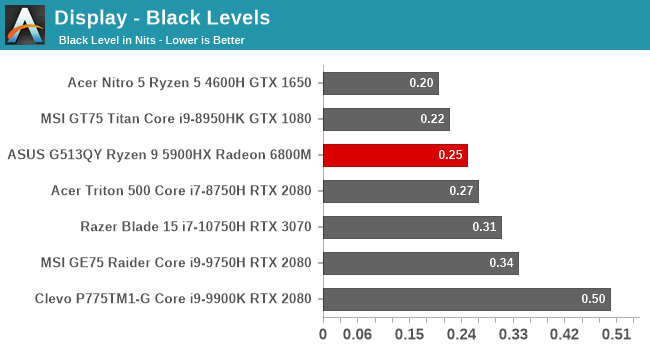
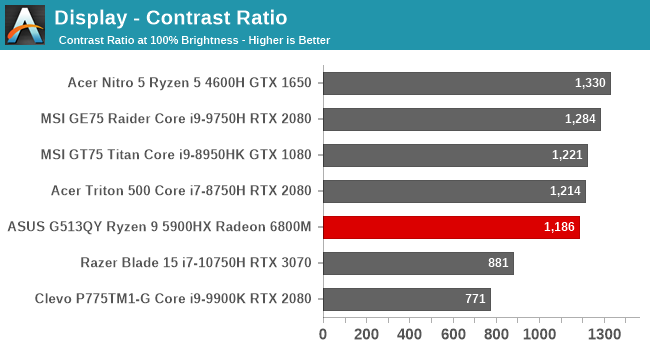
ASUS advertises the display as a 300-nit panel, and we measured 297.3 nits, which is pretty much right on the money. The contrast ratio is good, but not great, at 1186:1, measured at maximum brightness. Considering high-refresh rate panels used to be the domain of TN only, it is great to see the industry has been able to drive IPS panels such as this, relegating the TN to mostly a footnote in history in the PC space. For those that are curious, the display will go down to about 13 nits brightness at its lowest setting.
Grayscale
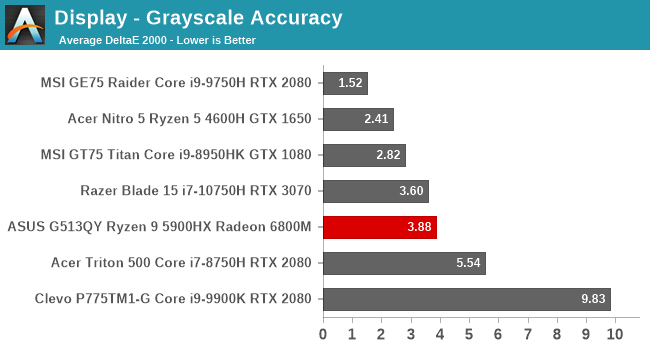
The panel in the review unit most certainly skews towards blue, although the overall error level is reasonable. A few years ago, this same device almost certainly would have shipped with a TN display with error levels around 10-12, so only seeing 3.8 average error is reasonable. ASUS does not hardware calibrate its panels, unlike say MSI, who offers a TrueColor application to choose and modify the color settings. Gamma is almost perfect on this display though, despite the white point being incorrect.
Gamut
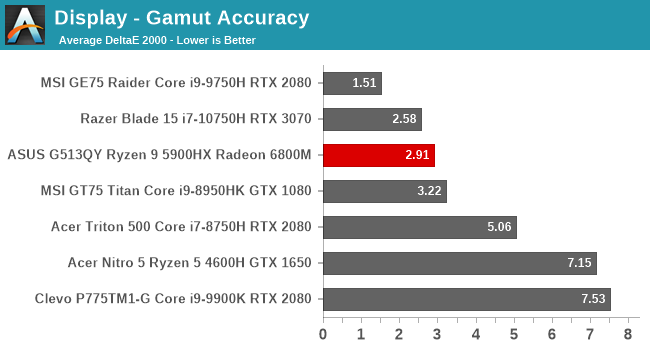
The gamut test checks the primary and secondary colors at the 100% level, and the ASUS display does indeed hit the sRGB gamut almost perfectly.
Saturation
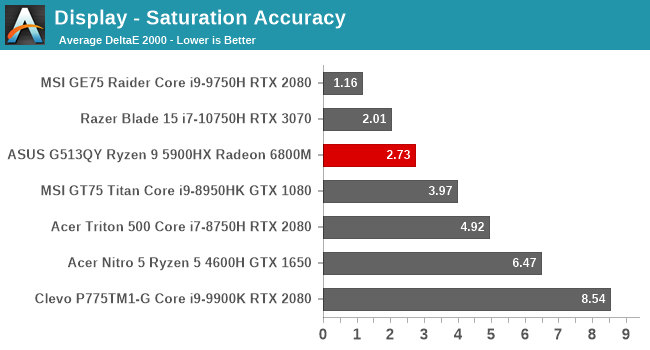
Unlike the gamut test, the saturation sweeps test all of the primary and secondary colors from 0% to 100% level at 4-bit increments. Other than Cyan, all of the colors are reasonably accurate considering this is not a calibrated display.
Gretag Macbeth
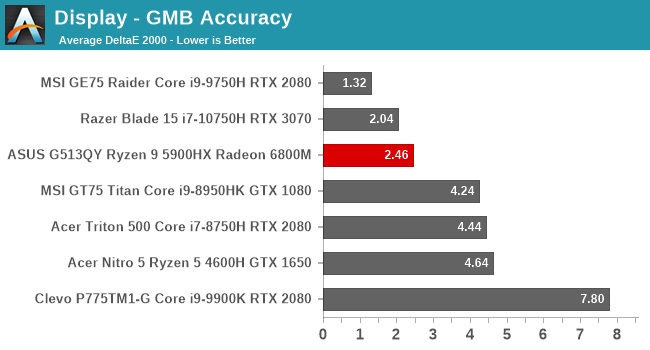
The final test targets colors outside of the primary and secondary color axis, including the important skin tones. Although some of the colors, especially the grays, exceed the 3.0 error level that would be considered inaccurate, most of the colors do fall under 3.0, making the overall average 2.5, which is very reasonable.
Colorchecker
Finally, the colorchecker is a visual representation of the testing done, with the targeted color on the bottom, and the actual color the display produced on the top. This is a relative result, as any errors in your own display will skew this result, but really, the ASUS panel is quite accurate with the exception of the extra blue levels in the grays.
Display conclusion
Considering this is not a calibrated display, it achieved quite good color accuracy, and really the only miss was the grayscale results which would be able to be adjusted using an ICC profile if a user wanted to make one. It is unfortunate that ASUS does not offer this built into hardware though, as ICC profiles generally do not work very well with games.
The other side of the coin is that this is a 300 Hz display, at just 1920x1080. Even with the massive Radeon RX 6800M, pretty much no game is going to hit anywhere near 300 FPS since the GPU is always bound by the CPU, making most of the refresh waste unnecessary. The 165 Hz QHD panel option would be the better choice, although it does target the P3 color gamut, which brings its own issues to the table on Windows PCs.















146 Comments
View All Comments
Makste - Tuesday, June 1, 2021 - link
Breath taking implementation. Swap the screen, I'll deal with the lack of webcam, I want this laptop.TOV - Tuesday, June 1, 2021 - link
Have you changed the RAM and test it again? Jarrod's tech test result +20% after he changed them.Techie2 - Wednesday, June 2, 2021 - link
If not for all the bribe money that Intel spends to prevent companies from building high end AMD laptops, AMD would own the laptop market based on performance. Asus has always taken the bribe money so don't expect them to embrace AMD significantly be it in laptops or desktop mobos.ToTTenTranz - Wednesday, June 2, 2021 - link
Why is the supposed GPU test page comprised of a bunch of CPU limited scenarios?ExarKun333 - Wednesday, June 2, 2021 - link
Why is this being compared to such old laptops? Why no 3080s with different TDPs and 10/11 gen Intel + ryzen 3000?IBM760XL - Wednesday, June 2, 2021 - link
Shut up and take my flatmate's money! He's got an MSI Raider with a 2080 (probably the same model in the comparison charts), and the whole flat agrees it's obnoxiously loud, even at idle. I'm going to show him this review tomorrow and tell him to sell the MSI and buy this as soon as it's available. Saying this as someone who has a (much quieter, somewhat thicker) MSI myself.Aside from the fact that my ears really want one of these in the house, it looks pretty nice in general. The fingerprint magnets are unfortunate, but otherwise it would very likely be in the running if I were in the market for a new laptop... or even just a powerful GPU in general. I'm excited to see AMD offer such a complete package, and at a reasonable price. The battery life for a gaming laptop is especially impressive. Gotta iron out those WiFi goblins though, I'd probably use it on Ethernet 85-90% of the time, but few things are more aggrieving in a computer than spotty WiFi.
boidsonly - Wednesday, June 2, 2021 - link
I've been wanting an all AMD laptop for a while now but never felt they were ready for prime time until now. If I can find this at MSRP I will buy it.FakThisShttyGame - Wednesday, June 2, 2021 - link
I wish they remove the screen and keyboard and keep this thin for my next gaming desktopDoofusOfDeath - Thursday, June 3, 2021 - link
Anyone know if the 2560x1440 panel will be brighter? I'm looking for a laptop that's usable in a semi-outside setting, and max 300 nits isn't ideal.Brett Howse - Friday, June 4, 2021 - link
The QHD is rated at the same 300 nits.